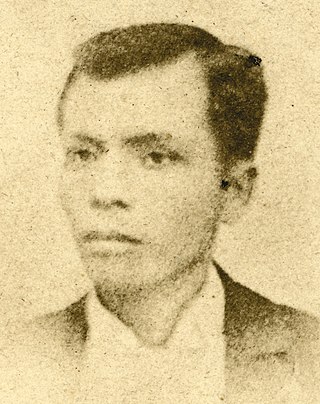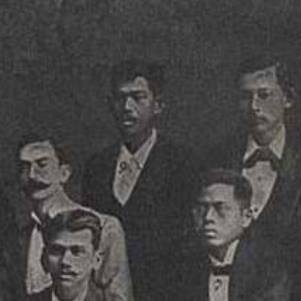| |||||
| Decades: | |||||
|---|---|---|---|---|---|
| See also: | |||||
This is a list of notable events that happened in the Philippines in the year 1897.
| |||||
| Decades: | |||||
|---|---|---|---|---|---|
| See also: | |||||
This is a list of notable events that happened in the Philippines in the year 1897.

As a colony of Spanish Empire and being a catholic, the following were considered holidays:

Emilio Aguinaldo y Famy was a Filipino revolutionary, statesman, and military leader who is the youngest president of the Philippines (1899–1901) and became the first president of the Philippines and of an Asian constitutional republic. He led the Philippine forces first against Spain in the Philippine Revolution (1896–1898), then in the Spanish–American War (1898), and finally against the United States during the Philippine–American War (1899–1901).

The Katipunan, officially known as the Kataastaasang, Kagalanggalangang Katipunan ng mga Anak ng Bayan or Kataastaasan Kagalang-galang na Katipunan ng mga Anak ng Bayan, was a Philippine revolutionary society founded by anti-Spanish colonialist Filipinos in Manila in 1892; its primary goal was to gain independence from Spain through a revolution.

Andrés Bonifacio y de Castro was a Filipino Freemason and revolutionary leader. He is often called "The Father of the Philippine Revolution", and considered one of the national heroes of the Philippines. He was one of the founders and later the Kataastaasang Pangulo of the Kataastaasan, Kagalanggalangang Katipunan ng mga Anak ng Bayan or more commonly known as the "Katipunan", a movement which sought the independence of the Philippines from Spanish colonial rule and started the Tagalog Revolution. With the onset of the Revolution, Bonifacio reorganized the Katipunan into a revolutionary government, with himself as President (Pangulo) of a nation-state called "Haring Bayang Katagalugan", also "Republika ng Katagaluguan", where in "Tagalog" referred to all those born in the Philippine islands and not merely the Tagalog ethnic group. Hence, some historians have argued that he should be considered the First President of the Tagalogs instead of the Philippines; that is why he is not included in the current official line of succession.

The Philippine Revolution, also called the Tagalog War, was a conflict waged by the Filipino revolutionaries against the Spanish colonial authorities in an attempt to win the country's independence.

Baldomero Aguinaldo y Baloy was a leader of the Philippine Revolution. He was the first cousin of Emilio Aguinaldo, the first president of the Philippines, as well as the grandfather of Cesar Virata, a former prime minister in the 1980s.
Miguel Malvar y Carpio was a Filipino general who served during the Philippine Revolution and, subsequently, during the Philippine–American War. He assumed command of the Philippine revolutionary forces during the latter, following the capture of resistance leader Emilio Aguinaldo by the Americans in 1901. According to some historians, he could have been listed as one of the presidents of the Philippines but, as of 2022, is not recognized as such by the Philippine government.

Mariano M. Álvarez was a Filipino revolutionary and statesman.

The Thirteen Martyrs of Cavite were Filipino patriots in Cavite, Philippines who were executed by musketry on September 12, 1896, for cooperating with the Katipunan during the Philippine Revolution against Spain. The de facto capital city of Trece Martires in Cavite is named after them.

Ladislao Diwa y Nocon was a Filipino patriot who was among the founders of the Katipunan that initiated the Philippine Revolution against Spain in 1896.

Mariano Trías y Closas is considered to be the first de facto Philippine Vice President of that revolutionary government established at the Tejeros Convention - an assembly of Philippine revolutionary leaders that elected officials of the revolutionary movement against the colonial government of Spain. When that assembly broke into factions, a truce known as the Pact of Biak-na-Bato was signed by the group and also recognized the elected officials and Trias as the vice president of Emilio Aguinaldo, who is also considered to be the first President of the Philippines. With the promulgation of the Malolos Constitution by the Malolos Convention, the First Philippine Republic was born. Under the Aguinaldo administration, Trias served in the cabinet initially as Secretary of Finance and, later, as Secretary of War.

The Tejeros Convention, also known as the Tejeros Assembly and the Tejeros Congress, was a meeting held on March 22, 1897, between Katipunan factions of Magdiwang and Magdalo in San Francisco de Malabon, Cavite that resulted in the creation of a new revolutionary government that took charge of the Philippine Revolution, replacing the Katipunan. It followed on a previous meeting now known as the Imus Assembly. Filipino historians consider the first presidential and vice presidential elections in Philippine history to have been held at this convention, although only Katipuneros were able to take part, and not the general populace.
Daniel Tirona y Tria was a Filipino politician. He became infamous for causing divisions within the Philippine revolutionary movement and for insulting and maligning Andres Bonifacio during the Tejeros Convention in 1897.
The Battle of San Juan del Monte also refers as "Battle of Pinaglabanan" took place on August 30, 1896. It is considered as the first major battle of the Philippine Revolution, which sought Philippine independence from Spain. The first battle cry of the Katipunan coincided with the pealing of church bells at nine o'clock on the night of August 29, 1896.

The Battle of Binakayan–Dalahican was a simultaneous battle during the Philippine Revolution that was fought on November 9–11, 1896 that led to a decisive Filipino victory. The twin battle took place at the shores of Binakayan, in the town of Cavite Viejo ; Dalahican and Dagatan in Noveleta; and, to minimal extent, in Imus and Bacoor towns in Cavite, Philippines that lasted for two days before the Spanish army retreated demoralized and in disarray. The result of the battle was the first significant Filipino victory in the country's history.
1896 in the Philippines details events of note that happened in the Philippines in the year 1896.

El Presidente: General Emilio Aguinaldo Story and the First Philippine Republic, or simply El Presidente, is a 2012 biographical film written and directed by Mark Meily about the life of General Emilio Aguinaldo, the first president of the Philippine Republic. The film stars Jeorge "E.R." Ejercito Estregan in the title role, along with Nora Aunor, Christopher de Leon, Cristine Reyes, and Cesar Montano.

General Mamerto Natividad y Alejandrino was a haciendero and a Filipino military leader who led numerous successful battles during the Philippine Revolution against the Spaniards. He is credited with establishing army headquarters at Biak Na Bato, which today is a national park because of its historical significance. Together with Jose Clemente Zulueta, he wrote the proclamation entitled “To The Brave Sons of the Philippines”, which called for the expulsion of the friars from the Philippines. He was a signatory to the Biak Na Bato convention, but a steadfast dissenter to the Treaty of Biak Na Bato, which asked for peace and reforms. He preferred independence.

The Thirteen Martyrs of Bagumbayan were Filipino patriots in the Philippines who were executed by musketry on January 11, 1897, for cooperating with the Katipunan during the Philippine Revolution against Spain.
This is the timeline of the Philippine Revolution. It contains the events before and during the revolution.

Salvador Estrella was a Filipino general who fought in the Philippine Revolution and the Philippine–American War. For his courage in battle, he earned the moniker "red blooded."